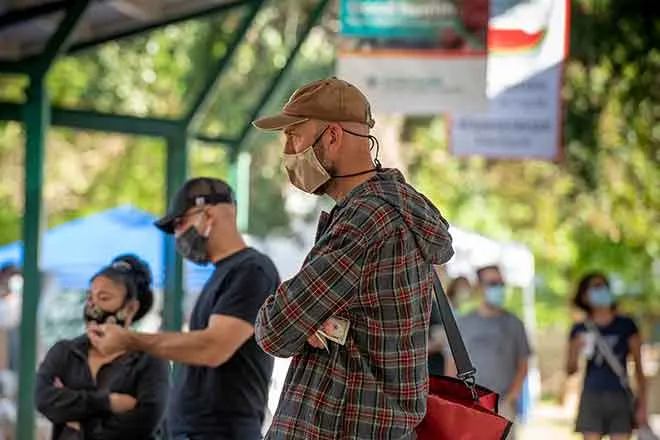
Daily Audio Newscast Afternoon Update - November 26, 2024
News from around the nation.
U.S. imports from Canada, Mexico, and China in play as Trump vows tariffs; Wildfire toolkit helps CA Hispanic families prepare; Activist: Dairy may not be the best way to get your calcium; AARP expands 'Care for Caregivers' course to more WY communities.
Transcript
The Public News Service Tuesday afternoon update, I'm Mike Clifford.
President-elect Donald Trump said he plans to use executive orders when he takes office in January to institute tariffs of 25 percent on all products imported from Canada and Mexico and 10 percent on those from China, that from the Washington Post.
They report those tariffs on the United States' three largest trading partners would be in retaliation for the flow of fentanyl and migrants across U.S. borders.
More than $1.3 trillion worth of goods come from those three countries in 2023, according to the Census Bureau data, including gas, cars and smartphones.
And low-income Latino communities often bear the brunt of wildfires, so the Hispanic Access Foundation offers a wildfire management toolkit and video series to help families and policymakers prepare.
So far this year, more than a million acres have burned in wildland fires in California.
That's more than three times what we lost in 2023.
Hilda Berganza is the foundation's climate manager.
She says Latinos who work outside in agriculture or construction are at high risk from the smoke.
When there's a wildfire near, they don't stop working because they're not allowed to or because they don't know.
Lung cancer, asthma rates are going up from the wildfire smokes and different air pollutants.
Latinos are also less likely than their white neighbors to have home or renter's insurance, so losses hit harder.
I'm Suzanne Potter.
And activists say the Department of Agriculture could have us all fooled when it comes to the benefits of drinking milk.
We get the details of this sentiment, Texas News Service collaboration.
Author Alyssa Hamilton says during World War II, the government needed farmers to increase dairy production to provide powdered milk to soldiers overseas.
The move created a surplus of fluid milk and the USDA created the National School Lunch Program in 1946, requiring schools to include milk with every meal.
You can dump all this excess milk into the schools and that began that three glasses of milk is essential to a healthy diet and for growing children and calcium for bones.
I'm Freda Ross reporting.
And November is National Family Caregivers Month.
About 58,000 Wyomingites provide needed care for sick or elderly family members or loved ones over an estimated 54 million hours of unpaid labor.
That's according to AARP Wyoming, which launched a Care for Caregivers series last year.
Stella Montano is with AARP Wyoming.
Have you noticed that maybe your parents are aging and you're assuming more responsibilities?
Or has someone been diagnosed with something that you might have to have oversight of their medical needs?
People don't believe they're caregivers, but they still have a lot of responsibilities.
There's more information for caregivers in all states online at aarp.org/caregiving.
This is Public News Service.
Next to Connecticut, where a new report shows that teacher pension financing reinforces inequality.
The Equitable Institute's report finds pupil pension subsidies are paid at less than 50 percent the rate for students of color compared with white students.
They're also paid at lower rates for low-income students.
Anthony Randazzo with the Equitable Institute notes the state must rethink how those subsidies are paid to school districts.
He says districts will realize the actual costs of teacher salaries.
By saying that they need to contribute some money towards teacher pension benefits, it would mean that every school district needs to think about, we're going to allocate a certain amount of money to salary to pay teachers a certain wage.
We're also going to have to pay a portion of that salary.
We're going to have to pay part of the employer contributions.
The employer contributions are always as a percentage of salary.
Since the state would be paying less in salary costs, Randazzo thinks those extra dollars can be redistributed to districts that need it more.
This can be done through the state's school funding formula or another mechanism.
The overall goal is that wealthier districts' residents would have to pay a bit more to keep their teacher salaries high, while needier districts would have money to pay teachers better.
I'm Edwin J. Vieira.
And after kids get concussions, a top concern for them and their parents is when they can go back to sports.
According to reporting from KFF Health News, kids should rest both physically and mentally in the first couple days after an injury before going back to school.
Dr. Julie Wilson with Children's Hospital Colorado says a relatively new step in concussion protocol can help shorten recovery time by several days.
But also start to exercise, typically aerobic activities, cardio, walking, stationary bike, swimming, things like that.
As soon as starting the first 48 to 72 hours after injury.
Kids returning to school may need extra support from teachers and breaks in their schedule to relieve symptoms such as headaches or fatigue.
More than 2 million children nationwide have been diagnosed at some point with a concussion or brain injury, according to the 2022 National Health Interview Survey.
This story was produced with original reporting from Kate Ruder for KFF Health News.
I'm Eric Galatas.
Finally, the USDA is funding agricultural projects across the US, including in states like Alabama.
But advocates say the lack of transparency raises doubts about where the money is going.
Jason Davidson with the nonprofit Friends of the Earth says this is largely due to the limited amount of information available.
The USDA has been very opaque in sort of describing not just the projects themselves, but even what sort of data they plan to collect.
He says major meat companies have received tens of millions of dollars through the USDA's Partnerships for Climate Smart Commodities program.
However, details about how the funds are being used remain vague, with only limited information on applicants, funding amounts and project summaries available.
Shantia Hudson reporting.
This is Mike Clifford for Public News Service, member and listener supported.
Hear us on great radio stations, your favorite podcast platform, finder content and trust indicators at publicnewsservice.org.

















